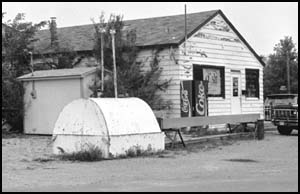 A gasoline leak at the former station on the corner Lake Avenue and Mill Street, approximately 10 to 30 years ago is apparently the culprit responsible for the present benzene contamination found in two of the four city wells.
A gasoline leak at the former station on the corner Lake Avenue and Mill Street, approximately 10 to 30 years ago is apparently the culprit responsible for the present benzene contamination found in two of the four city wells.
Jim McArthur, Minnesota Pollution Control Agency, Twin Cities, met with the Paynesville City Council Wednesday night and explained the results of their testing.
The MPCA had drilled more than 40 test holes at known sites of former gas stations.around Paynesville in February. "We poked quiet a few holes in town and checked out any possible site of contamination," McArthur told the council. "All the sites were clear of contamination except those near the former John's Service Station."
"We feel the contamination source is the old station at the corner of Mill Street and Highway 124," McArthur said. Among the former owners of the station include Emit Lebrenz, Bill Weber, John Nett, Ed Rondeau, and the State Bank in Eden Valley.
"There seems to be a good confining area of soil from Casey's corner and Highway 23 north. The contamination is sneaking through the confinement layer to the municipal wells. There seems to be an old stream channel south of Casey's consisting of coarse material which helps promote the spread of the contamination." He added that south of Highway 23 the subsoil consists of sand, allowing the contamination to spread.
He explained the city gets their water supply from a confined aquifer. The city sits above two aquifers, a shallow and a deep aquifer. "We found no contam-ination in the shallow aquifers," he said.
The gas tanks at the former service station in question were removed in 1989. The leak was discovered when the tanks were removed and a remediation system was installed in 1990 at the site.
Several years ago, 1,500 cubic yards of dirt containing raw gasoline was removed from the station site. However, gas is still found on the water table. "We won't get all the gas out of the site. It will go away over time, but that will take several decades," McArthur said. "Crews have tried to get rid of the worst contamination at the source already. We are not looking at digging up the road or the building as it is too expensive," McArthur stressed.
McArthur explained the MPCA needs to drill more test holes to find the area of magnitude of the contamination. "Before we can drill more test holes (between Casey's and City Hall) to monitor the spread of the contamination, we need to obtain permission from MnDOT," McArthur added.
McArthur suggested the city turn well number four (behind city hall) back on and pump the contaminated water into the sanitary sewer system, drawing the contamination away from the other wells, five and six located south of Highway 23 east of the Paynesville Greenhouse.
Tests done at well number three at the city garage near Cenex show the benzene contamination levels have dropped to one part per billion and after treatment are nondetectable, making the water safe to drink.
He added a feasibility study will be done to seek possible solutions and cost estimates for various options.
McArthur stressed to the council that wells three and four need to be replaced.
Pete Carlson, city engineer, suggested the city submit an application for $300,000 to the Minnesota Department of Health for a loan from their revolving loan fund. "We will probably be looking at drilling two new wells this year and the application deadline is May 29," he added.